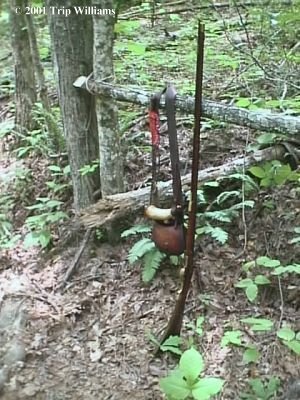
(Rifle Shown is courtesy of Ghost)
*Black Powder Weapons*

Who among us has not thought about the life and romance of being a "Mountain Man" or African Ivory Hunter? Living our lives on our terms, responsible only for ourselves, beholden to none, exploring new frontiers with traps slung over one shoulder and a Black Powder Rifle held firmly in one hand... It's an image of life that lasted only for a short time in the 1700's and 1800's, and the life expectancy of the average "mountain man" or Ivory Hunter was about 2-3 years... Not a good life to live. However, the explorers of yesterday can teach us a lot today. They lived with a minimum of equipment in a harsh environment, making their own way in life... The Black Powder Rifle played an important role in that life.
Black powder rifles are no longer the "weapon of choice" for survivalists or outdoorsmen. They are largely used just for fun and sport now, having been replaced with modern bolt action Rifles or auto-loaders using center-fire cartridges. The Black Powder Rifle of yesteryear was finicky at best, and didn't work at worst. They were much more affected by weather conditions than modern weapons, and moisture always made the next shot a crap-shoot... this is not a reassuring thought when you're facing down an angry grizzly bear, or a charging Elephant on the African continent. Thousands of unmarked graves around the world are due to that most horrible of sounds to man in a dangerous situation armed only with a Black Powder weapon... What sound is that? "Click"
Having spoken of the downfalls of Black powder rifles, let's also look at the upside. There's little or no regulation of Black Powder Weapons, "Modern" technology has made them easier to shoot and easier to care for... not to mention making them more reliable. With the advent of plastic storage containers, moisture in your powder is no longer a real problem, and modern percussion caps have replaced flintlock "powder pans" and made it so that you can use a Black Powder Rifle, at least semi-reliably, even in a downpour. If you stay away from the commercial "gizmo's" becoming popular to BP shooters, it can even be an inexpensive hobby.
Another thing to look at is the "camouflage factor" inherent in "antique" firearms.. no one see's a BPR (Black Powder Rifle) hanging over the mantle piece as a "real weapon" any more. Also, it IS possible to manufacture your own Black Powder, although I surely don't recommend it. I know people who spend a lot of time making their own "Quality Black powder" and melting down tire balancing weights to make their own lead balls. They declare that they can still hunt with BPR's even if there was NO modern equipment left in the world. I find that scenario highly unlikely, but it IS fun to shoot and hunt with BP Weapons.
The Basics
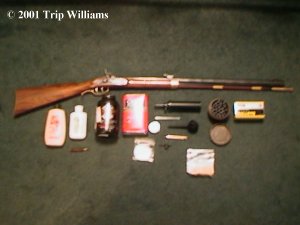
There's nothing mysterious or hard about shooting BPR's. They are pretty forgiving of small errors, but they are very unforgiving when abused. The basic needs for BPR's are simple:
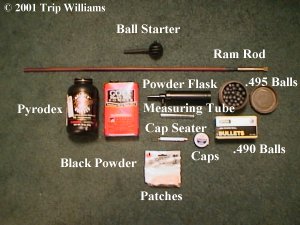
Black Powder Weapons
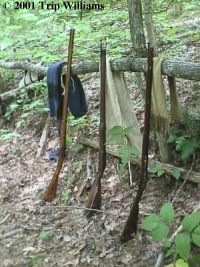
There are MANY different styles, makes, models, brands, etc of Black powder weapons on the market today. They start as inexpensive as 100 bux, and can run on up into the thousands of dollars. Take my advice, get an inexpensive model to begin with, because until you deal with the corrosive effects of Black Powder components, you have NO IDEA how hard maintenance on these weapons can be. It's a constant battle against rust and corrosion. We're used to modern rifles and non-corrosive components... you can get away with doing a "quick cleaning" on modern rifles, but Black Powder weapons don't cut you any slack!
Whole Books could be (and have been) written on just the subject of different types of BPR's. Since I am just seriously beginning to love the art of BP shooting, I'll leave that topic the pro's and simply sick to the basics. I have seen a few people new to BPR's start out with the earlier models of front end loading charcoal burners with flintlocks, and they get discouraged. There IS an art to it. I suggest you start with a basic BPR in a common caliber that accepts a percussion cap. Once you get an "entry level BPR" and get the "thrill of shooting it" out of your system, you'll start finding people who take BPR's seriously and know them in detail... They can teach you a lot more than any book or article and help you can make more knowledgeable decisions on future rifle purchases.... it's addictive, trust me.
I got my BPR in a trade with a good friend, and knew enough about it to know that I didn't know jack-$}{!t. I waited until the 2001 Rubicon International Campout and let the professionals (Ghost and Hipshot) show me how to operate it. Let me say that these two guys know their stuff. They aint gun range commandos, they take their sports very seriously. Almost any weekend will find them out at a reenactment or "rendezvous" in period costume with period authentic equipment. These guys have some BEAUTIFUL (and expensive) gear and weapons!
I was nervous about shooting a .50 caliber cannon as I'd already heard all the horror stories about blowing my face off from any number of potential accidents (Some are true, most are not). I was also given some advice which I still adhere to... "There's always some nut at the gun range that knows ALL about your BPR... stay away from them". I relayed my fears about my face being blown off, and both Ghost and Hipshot smiled at each other...
After Ghost inspected my BPR and determined that it wasn't likely it'd kill me on the first shot, Hipshot loaded her up and handed her to me for the first shot... I cocked the hammer, squeezed the set trigger till it clicked, and then touched off the powder charge with the front trigger... I had the butt of the rifle FIRMLY against my shoulder, so instead of ripping my arm off at the socket, the front of the rifle simple rose into the air to about a 45 degree angle. Smoke was everywhere. Ghost said "WHOA! What did you charge that thing with?" Hipshot smiled and said, "bout 90 grains".. Ghost said, "Looked more like 100 to me, Well War, he stress tested your rifle for you"....
Point being, I wasn't afraid of it blowing up any more. We settled on a load of 60 grains of Pyrodex and I've been happily pounding away with my BPR ever since. Till you've hit a good target with a .50 cal ball, you aint lived... I was hooked! ;)
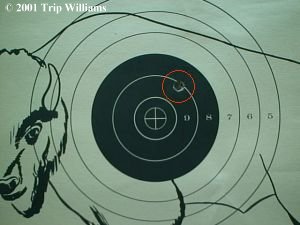
What Powder Do I use?
Ask a professional. I know what works for my rifle, but your mileage may vary with the weapon you buy. There are some good articles here on the subject of Black Powder, I suggest you read (and learn) about the differences in powder so you can make an educated choice (and know when some arm chair "expert" is BSing you).
One such article is by "Grunt" and can be found Here.
I will restate a common theme found in BPR shooting circles... "Pyrodex produces less smoke, is more reliable, and easier to clean up than traditional Black Powder".
Measuring Powder
As I said, BPR's are forgiving of small mistakes, but abuse or stupidity WILL result in injury or death. There are several things that can cause an explosion of biblical proportions... A ball that is not fully seated, a double load of ball in the barrel, and mismeasured powder.
We found the "sweet load" for my rifle by measuring it with a scaled measuring tube (looks like a test tube with grains printed on the side). Once we established my load, we set my powder flask so that 3 pre-measured charges from it was perfect. My Flask is not expensive, the powder is stored in the large back end of it, and a button on the front "drops" each charge. You put your finger over the small end of the flask, push the button to let the small chamber fill up with powder, then dump the charge into the barrel of the BPR. Like I said, my powder flask is adjusted so that doing this 3 times gives me my "perfect load". I suggest that you keep a small notebook with you to write down your powder types, loads, weather conditions, other powders tried, etc. This will soon give you a good idea about your rifle, and the best loads/powder types to use.
NEVER "eye" a charge. Measure each charge every time. It looks cool in the movies seeing Hawkeye running while dumping powder down his barrel "by eye", but that's Hollywood and they aint responsible for your face.
Powder flasks start at about 5 bux and can run up into the hundreds for hand carved horn models.. some are truly works of art. Let me save myself some future typing here and say that with ANY piece of BPR equipment you have an inexpensive "basic price", and a high end "art carved Price".. nuff said on that subject, just take it as a given from here on.
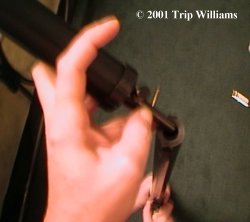
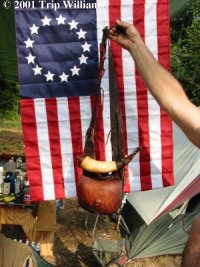
Patches
Patches come in a many shapes and sizes, none of which is super critical. They come plain, pre trimmed, lubricated, etc etc etc... get something cheap to start out with that fits the caliber of gun you bought. Most are just cotton patches which look strangely like bore cleaning patches, just a little smaller.
Some genius a long time ago figured out that if he cut grooves into the barrels of Black Powder Cannons and rifles, that he didn't have to clean the fouling out of the bore as often between shots. The unburned powder and other gunk stayed down in the grooves and away from the ball. It was probably that same genius that found twisted grooves in a rifle made the ball spin which resulted in more accurate shots at longer distances. Anyway, I give you that history lesson to explain one of the functions of patches. Balls, are not perfectly round, and they don't perfectly fit the bore of your rifle. A patch seals up the gap between the ball and bore of the rifle so that the burning gas pushes the ball out of the rifle and doesn't just blow gas past the ball, AND it shapes itself into the rifling of your barrel to help the bullet spin.
After you dump the correct load of powder into your rifle, get into the habit of automatically sticking a patch on top the barrel and stick a ball on top of that.. press the ball down ON to the barrel just a bit. This way you don't run the risk of doing things backwards (which WILL happen, even to the pros) and you don't jam two balls into the barrel while you're distracted talking to your friends. You'll see the white patch and ball sticking in the end of your rifle.
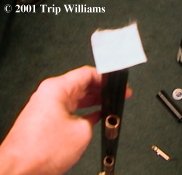
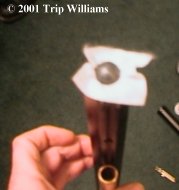
Balls
This a subject of great debate among serious BPR shooters. I don't see the point of the debate, but then again I aint in their league. I aint to a point yet of pin point accuracy, I'm still happy when the BPR goes BOOM and the ball hits reasonably close to the center of the target ;)
A .50 caliber weapon doesn't take a .50 caliber ball. Some people use .490 caliber balls, others prefer .495 caliber balls.. about the only difference I can see with my poor rifle (and my poor shooting) is that one is a little harder to ram down the barrel than the other. I know, I know, you can use a tighter ball and less powder, you get more spin with a tighter ball, etc, etc, the mutations are endless... Like I said, at the beginning of your BPR experience, go for "easier to shove down the barrel".. you can mix and match powder and ball sizes later as your experience grows.
Most BPR hunters prefer "Sabots". These are small conical bullets wrapped inside a plastic hull. You don't use a patch with these, the plastic hull acts as the patch. Turkey hunters love em, but at one to two bux per shot, I'll stick to balls at 5 dollars per hundred ;) Sabots are more accurate and have a higher muzzle velocity, but again they are expensive and they leave a plastic coating in your barrel that must be scrubbed out later.... Life always has trade offs.
Bullet Starters
Nothing special here. Depending on what size ball you use, you may or may not need one of these. They are cheap for basic models (a buck or two) so I'd recommend getting one. They are just a small rod with a cupped out part on one end, and a rounded handle that fits your palm on the other end. They're only about 4-5 inches long.
The fun part of BPR shooting is BSing with the other shooters between shots. Since it takes so long to reload a BPR, you have PLENTY of yacking time while everyone discusses the last shot, and every other topic imaginable.
Now that yer finished yacking and ready to shoot, you have to seat the ball that you stuck on the end of your rifle... you can SEE the ball and patch sticking up, so you know at a glance where you are in the loading process.
Everything from here on should be done WHEN YOU ARE ACTUALLY READY TO SHOOT... yacking is finished at this point until you take your shot. Do the next few steps completely and without pause or distractions!
Take your ball/bullet seater and put the curved end over the ball and smack the rounded palm handle to seat the ball a little deeper into the barrel.
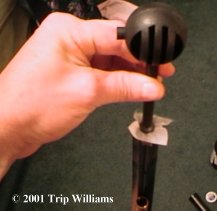
Ram Rods
Don't skimp here. Less expensive BPR's come with a cheap ram rod hanging under the barrel, usually wooden with a screw hole on one end for removable rams, cleaning brushes, etc. These rods will be abused, so while you're buying your rifle, spend a few extra dollars and get a quality ram rod. A wooden ram rod may splinter as you jam a ball down your barrel with it, and go into (or through) your hand. Get a better (and probably longer) rod.
Take your ram rod, and force the ball and patch down the barrel using short (but smooth) jamming motions, each stroke with the rod will be a little longer than the last... push the ball and patch down onto the top of your previously dumped powder charge FIRMLY. You'll hear the sound of the "tonking" change as the ball is forced down the barrel and it will change again as the patch and bullet hit the powder firmly. You'll probably also hear air puffing out of the cap nipple as the ball makes it way down the barrel. When the bullet is fully seated against the powder, You can drop the rod down the barrel and it'll "bounce" with a solid ringing sound.
If the ball is NOT firmly seated against the powder charge, you have an expansion space between the powder and ball. Gas pressure can build up to dangerous levels before the ball ever starts to move down the barrel if this happens... yes, this is one of those real times you could end up missing your face... It's rare, but it happens. Make SURE the ball is firmly tamped onto the powder charge!
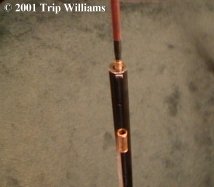
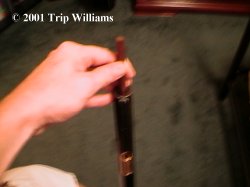
Percussion caps
These little devices are what made shooting a BPR in many different weather conditions possible.
The old flint lock rifles (which are still popular among BP purists) used a pan to hold a small amount of "ignition powder" that would ignite the main charge in the barrel. Since animals don't stand still while you load your rifle, you have to load your rifle before the animal see's you... powder laying in an open pan wouldn't stay in the pan for long as you moved around in the woods, and if it was wet outside, the powder WOULD get wet.. a device called a "frizzin" or "Frizzen" (depending on who you listen to) was swung into place over the pan to hold the ignition charge in place. The frizzen also has a metal strike plate sticking up from it. A piece of sharp flint was held in place in the "lock" by a pressure screw. When the trigger was pulled, the lock slammed forward causing the flint to hit the metal strike-surface of the frizzen, this (hopefully) caused a shower of sparks to fly onto the ignition powder as the frizzen was forced backwards, uncovering the powder in the pan. If everything went well, the powder in the pan would light up, go into the "flash hole" and ignite the main powder charge in the barrel... if the powder in the pan ignited without setting off the main charge in the barrel, it was called "A flash in the pan" (A term still used today).
If all that sounds complicated to tell about, it's complicated in practice also. Most of us BPR shooters have a secret shrine built in our closets to the man that invented the percussion cap. All of the above descriptions about the powder, pan, frizzen, lock, flint, etc, etc, was replaced by one tiny, simple, inexpensive ignition cap. They run just a few bux per hundred.
BPR's have a "nipple" with a flash hole in it's center, right under the lock or (as they are referred to in modern weapons) a hammer. The percussion cap is basically a tiny cup made of tin foil and filled with a shock sensitive chemical. The cap fits right over the nipple.
Cock the hammer back until it clicks once into it's "half cocked" position (another saying still in use today), and using a cap seater, put a cap onto the nipple. A cap seater is just a little rod or tube with a spring keeper on one end. It holds several caps and allows you to simply "strip" a cap onto the nipple.... you can put a cap on a nipple with your fingers, but when your fingers are cold you end up dropping a lot of caps. Cap seaters are only about a dollar and they make things much simpler, so I recommend their use.
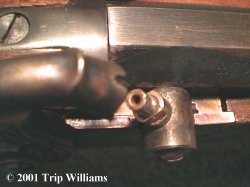
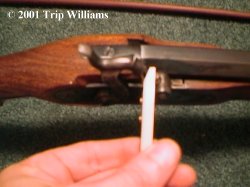
Ready to shoot
Now you're ready to take a shot. I am assuming you already know the Safety basics of shooting ANY weapon. If not.. you're in the wrong area anyway.
At this point, shooting the BPR is almost like shooting any modern rifle... almost. Fully cock the hammer now and finish getting lined up on your target. Your BPR will probably have a "set trigger". A set trigger is a second trigger behind the main trigger. Since you only get ONE shot, you want it to be VERY accurate. When you squeeze the back set trigger you'll hear a slight "click" and nothing will happen visibly. What you've just done is literally turned the main front trigger into a "hair trigger". The weight of your finger on the front trigger will set the BPR off. This takes some getting used to. You'll inevitably fire the weapon too fast the first few times you use the set trigger, so DO NOT TOUCH the front trigger until you are lined up on target and have pulled the weapon HARD into your shoulder.
You don't have to use the set trigger, but without it, most BPR's have a long and creepy trigger pull... your accuracy will greatly increase by learning to use it correctly.

Now What?
Now touch the front trigger... BOOM!
"GOD, What just happened?!?! Is my face still on my skull?!?!? I can't see!!! My Arm is numb!!!"
Yes, your face is most likely still there. You can't see due to all the smoke, and your shoulder is hurting because you didn't pull the rifle butt in tight before you touched the trigger... I TOLD ya it was light!
Actually, due to the weight of most BPR's, they don't kick very badly if you shoot properly... they certainly kick less than a modern single shot shotgun! Guns shouldn't "kick", if properly done, they should "push".
Wait a minute or so for the smoke to clear (yet another saying still in use), and look down range at your target. You probably don't even need a spotting scope to see the large hole! At this point, you and your friends can go back to BSing.
A trick I learned from Ghost and Hipshot is to swab out the barrel with an alcohol pad while you BS with your friends. This gets out a large majority of the fouling, makes your next shot more accurate, Cools the barrel, puts out any smoldering powder left in the barrel, and makes later cleaning MUCH easier.
At this point, you can dump another charge in the barrel, put on a patch and press a ball onto the end of the barrel and yack while you wait for your turn to shoot to come up again. The process repeats at this point for as long as your breath and shoulder holds out.
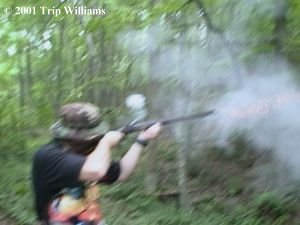
Cleaning
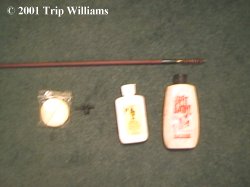
Here is the BEAR when it comes to BP shooting :) You don't clean a BPR like you would a modern rifle.
Most BPR's are easy to break down since men on the frontiers couldn't carry a lot of equipment. Mine has one pin that takes down the weapon. Once broken down, you swap out the barrel VERY VERY good with a quality solvent. I had a hard time keeping my BPR clean until Ghost gave me a home made concoction containing cleaners and Murphy's oil soap (I'll have to ask him for the exact recipe ;)
(UPDATE: This came in from "Roadkill", and is the formula for the stuff mentioned above):
"Just mix equal parts of: 1. Murphy's Oil Soap 2. Rubbing Alcohol 3. Hydrogen Peroxide. I mix a quart of each in a gallon jug. Haven't found anything that works any better. Just remember to wipe all cleaner off and liberally oil down, as this formula obviously won't prevent rust."
(Thanks Roadkill)
A product called "Bore butter" makes life easier too. You'll need a QUALITY bore brush which fits on the end of your ram rod, and a "patch pusher" that makes a patch stick to it so that it can be removed after the patch goes down the barrel. Since BPR's usually don't have an open breach, anything you put down the front of the barrel has to come back out of the front of the barrel.
You don't simply "scrub" the weapon, you "flush" the weapon liberally with cleaner, let it soak ("Saturate" is a good word to remember while cleaning ;). After allowing the solvent to soak, scrub the barrel with a good bore brush and swab with patches until NOTHING else comes off on a clean white patch. Repeated the "soaking scrubbing" process as needed. If you don't do this cleaning thoroughly, you'll end up with a pitted barrel, inside AND out. Clean it good, then in a few days, clean it again! Oil is your friend! BPR's rust just by looking at them!
You DO NOT want your bore full of solvents that stay "sticky" or they'll cause fouling later when you try to shoot the weapon again. When the gun is clean, you want the bore dry!
Before cleaning, make sure you take your nipple wrench and remove the cap nipple. The hole between the nipple and inside of the barrel needs to be cleaned VERY well or the nipple threads will rust out and then you have a real problem. Nipples are cheap, I replace them every few times that I go out shooting. Also, be sure to clean the area around the lock, nipple, etc VERY well since these have been covered by hot corrosive powder and igniter agents. They will pit the metal severely if not cleaned well.
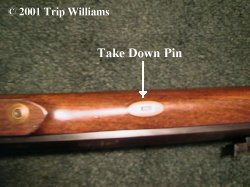

Store the weapon in a good quality case. If you add a desiccant pack to the case, keep it near the barrel, not the wood. Keep the wood coated in a good quality product made for wood. I use Murphy's oil soap, others use different stuff.
Other tips
I know that sticking a patch and ball on your rifle sounds funny, but there is a reason. No matter HOW professional you are, you will do several things at least once in your life of BPR shooting.... you'll either reverse the order of loading, IE, get distracted and shove a patch and ball down your barrel and THEN add your powder... or forget you loaded the weapon already and load it again. With a backwards load, nothing much happens, you just get laughed at by your friends (who've either done it themselves, or WILL do it themselves someday). If you "double load" your rifle, you'll probably notice because you'll know how far down your barrel your ram rod usually goes when your BPR is properly loaded. If you don't catch the mistake, you probably will still keep your face intact, but it's a very dangerous situation. Dumping your powder and then sticking on a patch and ball lets you see where in the loading process you are. Get a "loading pattern" down and follow it always. This is what works for me. Just before I am ready to shoot, I ram the patch and ball down the barrel, add a cap and shoot.
NEVER start the loading process by putting a cap on the nipple first! Your face and hands are exposed to the end of the barrel during loading, and if the lock falls on the cap, you've lost at least some fingers and probably your life. The cap is the LAST thing you put in place!
NEVER smoke while around Black powder!... nuff said there.
If it's cold and you're having a bad "static hair day"... ground yourself to something before handling BP... a spark in a can of black powder can make one HELL of an explosion. Remember... modern powders "burn", black powder is classified as an explosive... there is a LOT of difference between modern smokeless powder and black powder.
NEVER use modern "bullet reloading powder" in your BPR... Stick to products made specifically for Black Powder Weapons such as black powder (duh) or pyrodex.
While cleaning, account for every one of your patches... make sure that two patches aren't stuck together. If you leave a patch in your barrel, the next time you go to shoot, you'll have no end of frustration wondering why the charge won't ignite.
As I Thanked Ghost and Hipshot for helping me along in the black powder world, They said "You thank us now, but eventually you'll hate us for it"... As the cost of getting better BPR equipment for my new addiction grows, I understand what they meant ;) But you'll never regret your decision to own a good Black Powder Weapon!
Warlord
All materials at this site not otherwise credited are Copyright © 1996 - 2001 Trip Williams. All rights reserved. May be reproduced for personal use only. Use of any material contained herein is subject to stated terms or written permission.